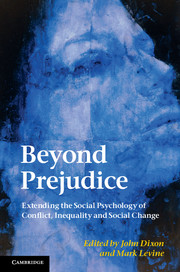Book contents
- Frontmatter
- Contents
- Figures
- Tables
- Contributors
- Acknowledgements
- Introduction
- Part I Beyond prejudice
- Part II Prejudice and social change revisited
- 11 Models of social change in social psychology: collective action or prejudice reduction? Conflict or harmony?
- 12 From attitudes to (in)action: the darker side of ‘we’
- 13 Contact and social change in an ongoing asymmetrical conflict: four social-psychological models of reconciliation-aimed planned encounters between Israeli Jews and Palestinians
- 14 From prejudice to collective action
- Conclusions and future directions
- Index
- References
11 - Models of social change in social psychology: collective action or prejudice reduction? Conflict or harmony?
from Part II - Prejudice and social change revisited
Published online by Cambridge University Press: 05 June 2012
- Frontmatter
- Contents
- Figures
- Tables
- Contributors
- Acknowledgements
- Introduction
- Part I Beyond prejudice
- Part II Prejudice and social change revisited
- 11 Models of social change in social psychology: collective action or prejudice reduction? Conflict or harmony?
- 12 From attitudes to (in)action: the darker side of ‘we’
- 13 Contact and social change in an ongoing asymmetrical conflict: four social-psychological models of reconciliation-aimed planned encounters between Israeli Jews and Palestinians
- 14 From prejudice to collective action
- Conclusions and future directions
- Index
- References
Summary
How could it be that creating more liking between members of different groups could be a bad thing? Only a bigot or a reactionary would question the value of intergroup harmony and encourage a positive view of intergroup conflict. Not too many years ago, no sensible social psychologists would propose that there could be too much concern about prejudice reduction. Social psychology has dedicated thousands of research articles to understanding the nature, the causes, the consequences and, of course, the reduction of prejudice (see Dovidio et al., 2010; Paluck and Green, 2009 for reviews). Underlying virtually all of this work is the assumption that reducing stereotyping and prejudice is essential to improving intergroup relations; that negative attitudes are at the heart of intergroup inequality; and that social justice is inextricably tied to strengthening intergroup harmony. Yet, there appears to be a growing number of us who have begun to question this ‘full speed ahead on prejudice reduction’ approach.
Nearly a decade ago, one of us (Wright, 2001, p. 415) proposed, although quite briefly, the possibility that although the strategies that effectively reduce prejudice might have very positive effects on members of the advantaged group,
from the perspective of disadvantaged groups, the same mechanism that serves to reduce the problems associated with advantaged group prejudice also weaken the impetus for members of the disadvantaged group to take collective action designed to reduce existing intergroup inequalities. Cross-cutting categorization effects (e.g., Brown and Turner, 1979), superordinate goals (e.g., Sherif, 1967), intergroup contact effects (e.g., Pettigrew, 1998), and many other strategies improve intergroup attitudes in part by changing the degree of differentiation between the groups and, thus, each of these might also reduce collective action by disadvantaged group members.
This idea sprung from the recognition that there had been little conversation between the literature on prejudice and the literature on collective action and social change. However, there are a number of inklings in the literature that have set the stage for a number of us (e.g. Dixon et al., 2007) to consider the limits of prejudice reduction as the sole, or even the most promising, route to meaningful social change.
- Type
- Chapter
- Information
- Beyond PrejudiceExtending the Social Psychology of Conflict, Inequality and Social Change, pp. 225 - 247Publisher: Cambridge University PressPrint publication year: 2012
References
- 56
- Cited by



